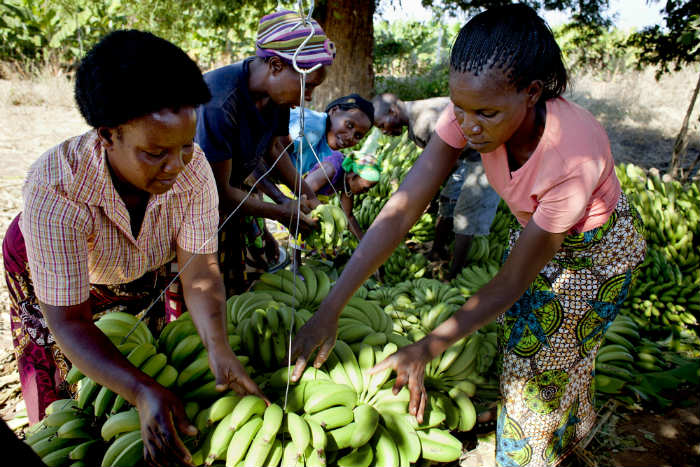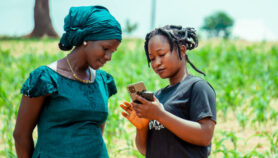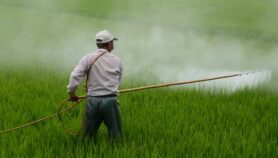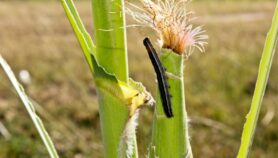Send to a friend
The details you provide on this page will not be used to send unsolicited email, and will not be sold to a 3rd party. See privacy policy.
Scientists in developing countries are scrambling to find a cure for a devastating fungus that threatens to wipe out the global banana trade and plunge millions of farmers into poverty.
Around the world, banana farmers are fighting a losing battle against Tropical Race 4, a soil fungus that kills Cavendish bananas, the only type grown for the international market. The disease was first spotted in the early 1990s in Malaysia, but has now started to wipe out crops in large parts of South-East Asia as well as in Africa and the Middle East. [1]
The Tropical Race 4 pathogen, a new strain of what is known as Panama disease, escaped from Asia in 2013. By 2015, it had infected plantations in Jordan and Mozambique, as well as Lebanon and Pakistan, with many scientists fearing an epidemic in Sub-Saharan Africa. [2]
“The impact on affected farms is immense, with significant losses of plants and the inability to eradicate the fungus from affected fields,” says Altus Viljoen, a plant pathologist at Stellenbosch University in South Africa.
The disease can be devastating for small banana farmers, who provide much of the 17 million tonnes of Cavendish bananas traded every year — mostly to rich countries where the fruit is popular as a healthy snack. [3] Bananas are also a staple food in many tropical countries, and the main source of protein for more than half a billion people around the world.
Tropical Race 4, a variant of the Fusarium oxysporum fungus, is transmitted by infected plant matter, but also from the clothes and shoes of plantation workers.
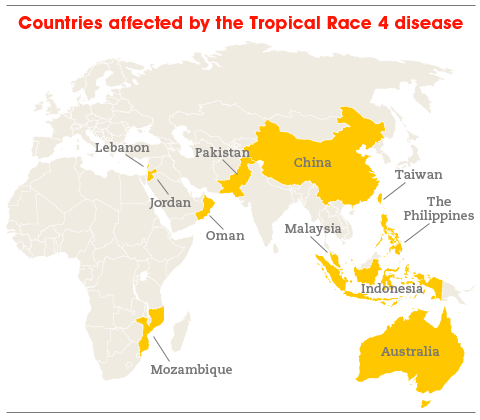
In Indonesia and Malaysia, the fungus wiped out more than 5,000 hectares of Cavendish bananas in 1992/93, says Agustin Molina, who leads the banana research efforts in the Asia-Pacific region for Bioversity International, a global research organisation.
“The banana export trade in Malaysia and Indonesia failed to prosper because of Tropical Race 4,” he says. “Now tens of thousands of banana farmers in the Philippines, China and Taiwan could be affected.”
Molina and his team try to work with local farmers to raise awareness of the threat and contain the spread of the fungus. He advocates footbaths, regulating the movement of workers and tough quarantines for seedlings and other imported plant matter.
But despite such efforts, Tropical Race 4 has crossed the Pacific Ocean. With the fungus now in Mozambique, other East African countries largely dependent on Cavendish exports — such as Uganda — fear for their crop.
“If nothing is done in the next ten years, billions of dollars worth of crop will be lost,” says Enoch Kikulwe, an associate scientist at Bioversity International’s Uganda branch.
The reason for Tropical Race 4’s rapid spread is globalised trade (see chart 1). Uganda, the world’s third largest banana producer, imports second-hand trucks and farming equipment from China, but these are rarely disinfected before shipping — putting the country at risk. Likewise, Sudan exports bananas by lorry to Lebanon and Oman, while seedlings grown in Jordan or Pakistan are sold to Mozambique.
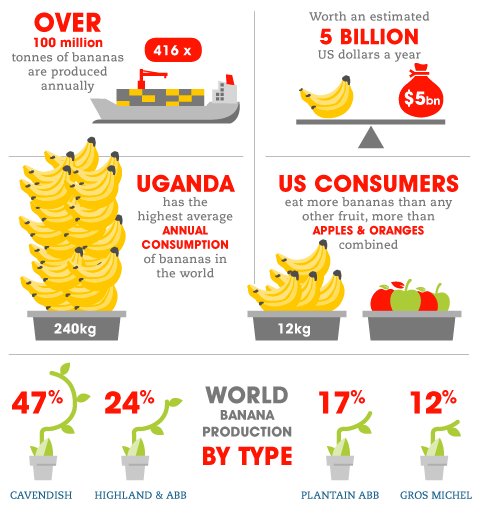


Credit: Panamadisease.org
Once the fungus has infected a plant it spreads to its xylem, the tubular tissue that transports water around the plant from the roots. These tubes get clogged, and the plant wilts and dies. The fungus continues to feed on the dead tissue and releases spores that enter the soil and attach to any material that comes in contact with the plant.
Sub-Saharan African scientists are stepping up research on the disease in the hope of preventing its continuing spread. But funding is scarce and local governments are not yet sufficiently aware, says Eldad Karamura, regional coordinator at the Banana Research Network for Eastern and Southern Africa.
“We are threatened,” he says. “We need greater awareness of the problem by policymakers and to train more scientists and buy equipment,” he adds.
At present, a laboratory at Stellenbosch University in South Africa is the only one in Sub-Saharan Africa that can test for the presence of Tropical Race 4. A Ugandan expert committee on the disease says the country could do testing too, but would need US$2.5 million to set up test facilities. More long-term plans could include research both on genetic modification to produce fungus-resistant plants and on other banana species to replace Cavendish in international markets, the committee says.
Karamura has seen first hand the devastation that Tropical Race 4 causes on banana plantations. “When I visit farms in Mozambique or Asia, I don’t come back to Uganda with my shoes — I leave them there,” he says.
However, the fungus poses the greatest threat to Latin America and the Caribbean. The region is responsible for 25 per cent of bananas grown worldwide, and 80 per cent of global exports. But local farmers are still reeling from a previous infection, this one caused by Tropical Race 1, the first instance of Panama disease.
Panama disease emerged in the 1950s in Latin America, nearly wiping out global trade in the Gros Michel banana, a predecessor to the Cavendish. As with Tropical Race 4, the fungus’s spores can survive in the soil for decades.
To get a sense of the potential impact of Tropical Race4 if it were allowed to spread globally, it helps to talk to Javier Chinchilla, a small-scale farmer of Gros Michel bananas in Costa Rica. He is sticking with the less popular banana type as he cannot compete with larger Cavendish growers.
The ghost of Panama disease haunts him still — his farm used to have 30,000 banana plants in the 1980s, but now he is down to 500.
“We sell Gros Michel at the farmer’s market, but it is increasingly difficult to get good crops” because the fungus lingers in the soil, Chinchilla explains. “My two brothers had to go out of business. Now it’s just me, my father and six other farmers that continue. But our families depend on our work with bananas.”
Chinchilla tries to keep his farm afloat by planting coffee, squash and maize in between the banana plants. But like thousands of other farmers in the region, he has abandoned large swathes of land to Panama disease.
“Production is, to some extent, nomadic,” says Ana Cecilia Tapia, an agronomist at the University of Costa Rica. “Farmers move their farms when a patch is contaminated, since there are no technological resources to attack the disease.”
The experiences of Phillippine banana growers with Panama disease
Faced with the high risk of Tropical Race 4 infection, the Central America-based International Regional Organization for Agricultural Health (OIRSA) has brought together researchers and policymakers.
The group tries to mobilise funds for research and preparation, such as better monitoring of crops. “We also coordinate actions with regional plant protection organisations and set up specialised groups for the care and handling of Tropical Race 4,” says Carlos Ramón Urías, OIRSA’s regional director for plant health.
The group advocates moving away from the current heavy reliance on Cavendish. There are almost 1,000 different banana species. If more of these were grown for sale, farmers would be less affected by the disease’s arrival, while the fungus would also have less chance to spread.
But the preferences of consumers, mostly in Europe and the United States, restrict these options. The Cavendish, which makes up 47 per cent of all bananas grown globally, is what many customers think the fruit should be: large, long and yellow. Because of this, farmers such as Chinchilla fear buyers will snub local varieties, which might be smaller, savoury or even red or green.
With little international action, the responsibility to find a solution, or at least a coping strategy, for Tropical Race 4 lies with scientists from the global South. [4] Chinchilla is working with researchers from the University of Costa Rica in the hope that it will help his farm survive the fungus, should it hit Central America.“We keep growing bananas,” he says. “By necessity, but also because we have given the researchers a vote of faith. They want to find a cure.”
This article was originally published on SciDev.Net's Global edition.
References
[1] A. B. Molina and others Recent occurrence of Fusarium oxysporum f. sp. cubense Tropical Race 4 in Asia in ISHS-ProMusa Symposium on Recent Advances in Banana Crop Protection for Sustainable Production and Improved Livelihoods (ISHS, 2007)
[2] N. Ordoñez and others First report of Fusarium oxysporum f. sp. cubense Tropical Race 4 causing Panama disease in Cavendish bananas in Pakistan and Lebanon (Plant Disease, January 2016)
[3] Gianluca Gondolini Fighting banana diseases — the end of Cavendish? (Food and Agriculture Organization of the United Nations, 5 February 2014)
[4] S. Vellema and others The threat of Panama disease to the role of banana and plantain in realising food security: linking local realities to a global problem (Wageningen University, 2013)


